Updates
Relief and recovery for animals and people in Myanmar
Read moreWhat is biodiversity?
Planet Earth is full of finely-tuned ecosystems. Everything works in tandem with one another to support life on the planet and the continued existence of humans and animals alike. However, human activity has damaged our ecosystems, leading to climate change, habitat destruction, and species extinction. As a result, we are seeing unprecedented losses in biodiversity all over the world. But what exactly is biodiversity, and why is it important?

In this blog, we discuss what biodiversity is, why it is crucial to the survival of our planet, and what can be done to protect it.
Biodiversity is a term that encapsulates the richness and variety of life forms found on Earth, from microbes living in the soil to elephants in the savannah to us humans in our cities.
Biodiversity encompasses three main components:
All three of these components are crucial to keeping the planet healthy and in balance. It has taken millions of years for Earth to arrive at the ecosystems we see around us today, and without this biodiversity, life would be unable to thrive.
However, we are at risk of losing this wonderful ecosystem and the species that depend on it through the actions of humans. Protecting and conserving biodiversity is not only a moral imperative but is also essential for ensuring the wellbeing of future generations and the health of our planet.
Understanding why biodiversity is important is crucial to our efforts to protect it. Let’s look at some of the reasons why biodiversity is key to maintaining the health of the planet.
Biodiverse ecosystems are more resilient to disturbances such as disease outbreaks, climate change, and natural disasters. They can recover faster and maintain stability in the face of external pressures.
Many crops depend on pollinators such as bees, butterflies, and birds for reproduction. Biodiversity supports pollination, ensuring not only the flourishing of many species but also the productivity of agricultural systems and food security.
Did you know that at least 120 critical drugs used all over the world are derived from plants? A significant proportion of pharmaceutical drugs are derived from natural compounds found in plants, animals, and microorganisms. Biodiversity serves as a vast reservoir of potential medicines and treatments for various ailments.
Forests, oceans, other ecosystems, and animals play a crucial role in regulating the Earth’s climate by sequestering carbon dioxide and mitigating the impacts of climate change. Areas of the planet that sequester large amounts of carbon dioxide are referred to as ‘carbon sinks’ and are key in maintaining the delicate climate conditions we need to survive.
Biodiversity enriches our lives in countless ways, from inspiring art and literature to offering opportunities for recreation, ecotourism, and spiritual connection with nature. This means it provides economic benefits, too.

Now that we know what biodiversity is and why it is important, let’s explore some of the main threats facing our planet’s biodiversity today.
This probably comes as no surprise but climate change is one of, if not the biggest threat to our planet today. Human activity has led to increases in greenhouse gases in our atmosphere, leading to rapidly warming global temperatures.
These rising temperatures, altered precipitation patterns, and extreme weather events also associated with climate change pose significant risks to biodiversity. Many species may struggle to adapt or migrate to suitable habitats as their current ranges become unsuitable.
Animals are adapted to their specific environments and ways of life, so by altering our ecosystems so drastically, humans are putting many animal species at risk of extinction.
Along with greenhouse gas emissions, human activities also release considerable amounts of pollutants into the environment. Pollution from various sources, including industrial runoff, agricultural pesticides, and plastic waste, contaminates ecosystems and harms wildlife. Chemical pollutants can disrupt hormone systems, impair reproduction, and weaken immune defences in animals.
And it’s not only animals that are at risk from pollution. The World Health Organisation estimates that approximately 6.7 million premature deaths annually are a direct result of ambient and household air pollution.
Habitat destruction and fragmentation is a pressing conservation concern the world over. The conversion of natural habitats for agriculture, urbanisation, and infrastructure development is a leading cause of biodiversity loss. Animals are forced to extinction by human encroachment as they no longer have suitable habitats in which to live and access to the resources they need to survive.
Fragmentation disrupts ecosystems, isolates populations, and reduces genetic diversity. In turn, this leaves populations vulnerable and less resilient to threats such as disease and poor weather conditions. It also increases the chances of human-wildlife conflict by placing humans and animals in closer proximity.
Invasive species are a leading cause of species extinctions and ecosystem degradation worldwide. Non-native species introduced to new environments can outcompete native species, disrupt food webs, and alter ecosystem dynamics.
The Intergovernmental Platform on Biodiversity and Ecosystem Services (IPBES) reports that human activities like travel, shipping, and trade have been responsible for the introduction of more than 37,000 animals, plants, and other organisms to environments where they don’t naturally belong.
These alien species disrupt natural ecosystems and have contributed to 60% of recorded global extinctions. As a result, invasive species are recognised as one of the five major direct drivers of biodiversity loss globally.
Unsustainable hunting, fishing, and harvesting of wildlife for food, medicine, and commercial trade can deplete populations and drive species to extinction. The illegal wildlife trade, in particular, poses a grave threat to many endangered species.
Biodiversity is no accident. It is a key cornerstone in the survival of the planet. In this way, many animals play crucial roles in their local ecosystems, helping to protect biodiversity and safeguard the environment. Read on to discover some of how animals protect biodiversity.
Many animals serve as ecosystem engineers. In other words, through their natural behaviours, they modify their ecosystems to promote biodiversity and keep the environment functioning as it should.
Elephants, for example, play many roles in changing and protecting their environment. They disperse seeds as they travel, fertilise the soil with their dung, and tear down trees and other shrubbery in their paths, creating new ways for animals to travel and mine resources from the mud.
Whales also play an important role in the health of our oceans. These mammals help to distribute nutrients across the ocean through their natural behaviours, supporting life across the food chain.
Although it may seem counterintuitive, predators play a key role in maintaining biodiversity by hunting prey populations. The natural relationship between predator and prey species keeps ecosystems in balance and stops one species from becoming dominant.
Without sharks, coral reefs would be unable to survive. Reef sharks keep populations of grouper and snapper fish under control through their natural hunting of these species. Without the sharks to keep populations in check, their numbers would be unsustainable. This, in turn, would lead to these species consuming more of their natural prey—algae-eating fish. Then, with fewer of these algae-eating fish present, algae would be free to consume coral reefs, leading to their destruction.
Another example of the predator-prey relationship maintaining biodiversity is in the action of wolves. Wolves are what is known as a keystone species, one that, if removed from their ecosystem, could lead to that ecosystem’s collapse.
This was seen when wolves were removed from Yellowstone National Park. The removal of the wolves led to an overabundance of deer, free to flourish once their main predator was removed. These deer overgrazed, destroying the habitats of other animals—such as birds and beavers—and forcing them out of their natural ecosystems.

Here at IFAW, we have many projects that aim to protect our planet and its natural biodiversity. For example, IFAW’s Room to Roam initiative is connecting elephant habitats in 12 key locations in Africa, restoring natural habitats and promoting biodiversity in the region.
With increasing human encroachment into elephant territories, elephant habitats are becoming more and more fragmented. This prevents African savannah elephants from travelling through the environment and fulfilling their role as ecosystem engineers.
Want to help support our work? Learn more about how you can take action for animals.
Our work can’t get done without you. Please give what you can to help animals thrive.
Unfortunately, the browser you use is outdated and does not allow you to display the site correctly. Please install any of the modern browsers, for example:
Google Chrome Firefox Safari